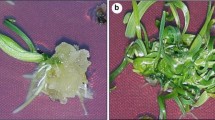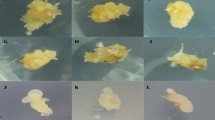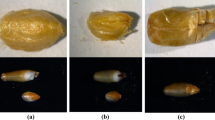Abstract
Hexaploid bread wheat, being highly recalcitrant, has been difficult to regenerate in vitro which limits the use of transgenesis and genome editing for its agronomic improvement and functional genomics. We have studied the comparative in vitro regeneration in six most important wheat varieties, namely, HD-2967, PBW-343, WH-1105, PBW-550, DBW-17, and WL-711, using immature vs mature scutellum. The regeneration response of varieties PBW-550, DBW-17, and HD-2967 has not yet been reported. The mature and immature scutella cultured on MS medium containing 2,4-dichlorophenoxyacetic acid (2,4-D) (2 mg l−1) or dicamba (6 mgl−1), respectively, and maltose (30 gl−1) under dark conditions developed calli which subsequently on transfer to modified MS medium with double concentration of NH4NO3, zeatin (5.0 mgl−1), dicamba (0.1 mgl−1), AgNO3 (2.0 mgl−1), CuSO4 (2.5 mgl−1), and sucrose (30 gl−1) under light conditions regenerated into shoots. Immature scutellum showed 100% callus induction irrespective of varieties and regenerated a maximum of 15 shoots per callus in 90% cultures, whereas mature scutellum showed a maximum 80% callus induction, producing maximum 5 shoots only in 67% cultures. Thus, immature scutellum has been more responsive comparative to mature scutellum for inducing callus and shoot regeneration. Among all the six varieties, HD-2967 was the most regenerative, which can be explored further for improving wheat via genetic transformation studies.


Similar content being viewed by others
References
Aadel H, Ahansal K, Udupa SM, Gaboun F, Abdelwahd R, Douira A, Iraqi D (2016) Effect of genotypes and culture media on embryogenic callus induction and plantlet regeneration from mature and immature bread wheat embryos. Agric Res 33:61–69
Barro F, Canalejo A, Martin A (1999) Genomic influence on somatic embryogenesis in the Triticeae. Plant Cell Rep 18:769–772
Bhalla PL (2006) Genetic engineering of wheat-current challenges and opportunities. Trends Biotechnol 24:305–311
Borrill P, Harrington SA, Uauy C (2019) Applying the latest advances in genomics and phenomics for trait discovery in polyploid wheat. Plant J 97:56–72
Chauhan H, Desai SA, Khurana P (2007) Comparative analysis of the differential regeneration response of various genotypes of Triticum aestivum, Triticum durum and Triticum dicoccum. Plant Cell Tissue Organ Cult 91:191–199
Delporte F, Mostade O, Jacquemin JM (2001) Plant regeneration through callus initiation from thin mature embryo fragments of wheat. Plant Cell Tissue Organ Cult 67:73–80
FAO (2016) World food situation: FAO cereal supply and demand brief. United Nations, Food and Agriculture Organization, Rome, Italy. Retrieved on 17 July 2018
Filippov M, Miroshnichenko D, Vernikovskaya D, Dolgov S (2006) The effect of auxins, time exposure to auxin and genotypes on somatic embryogenesis from mature embryos of wheat. Plant Cell Tissue Organ Cult 84:213–222
Ganeshan S, Chodaparambil SV, Båga M, Fowler DB, Hucl P, Rossnagel BG, Chibbar RN (2006) In vitro regeneration of cereals based on multiple shoot induction from mature embryos in response to thidiazuron. Plant Cell Tissue Organ Cult 85:63–73
Hakam N, Udupa SM, Rabha A, Ibriz M, Iraqi D (2015) Efficient callus induction and plantlets regeneration in bread wheat using immature and mature embryos. Int J Biotechnol Res 3:001–009
He GY, Lazzeri PA (2001) Improvement of somatic embryogenesis and plant regeneration from durum wheat (Triticum turgidum var. durum Desf.) scutellum and inflorescence cultures. Euphytica 119:369–376
Kavas M, Öktem HA, Yücel M (2008) Factors affecting plant regeneration from immature inflorescence of two winter wheat cultivars. Biol Plant 52:621–626
Kumar R, Mamrutha HM, Kaur A, Venkatesh K, Grewal A, Kumar R, Tiwari V (2017) Development of an efficient and reproducible regeneration system in wheat (Triticum aestivum L.). Physiol Mol Biol Plants 23:945–954
Lee RD-W, Cho H-T (2013) Auxin, the organizer of the hormonal/environmental signals for root hair growth. Front Plant Sci 4:448
Malik K, Birla D, Yadav H, Sainger M, Chaudhary D, Jaiwal PK (2017) Evaluation of carbon sources, gelling agents, growth hormones and additives for efficient callus induction and plant regeneration in Indian wheat (Triticum aestivum L.) genotypes using mature embryos. J Crop Sci Biotechnol 20:185–192
Mendoza MG, Kaeppler HF (2002) Auxin and sugar affects on callus induction and plant regeneration frequencies from mature embryos of wheat (Triticum aestivum L). In Vitro Cell Dev Biol Plant 38:39–45
Miroshnichenko D, Chernobrovkina M, Dolgov S (2016) Somatic embryogenesis and plant regeneration from immature embryos of Triticum timopheevii Zhuk. and Triticum kiharae Dorof. et Migusch, wheat species with G genome. Plant Cell Tissue Organ Cult 125:495–508
Mzouri K, Amssa M, Bouiamrine EH (2001) Somatic embryogenesis from immature embryos of wheat cultivars (Triticum aestivum L.): genotype effect. Acta Botanica Gallica (French) 148:215–225
Ortiz R, Braun HJ, Crossa J, Crouch JH, Davenport G, Dixon J, Dreisigacker S, Duveiller E, He Z, Huerta J, Joshi AK (2008) Wheat genetic resources enhancement by the International Maize and Wheat Improvement Center (CIMMYT). Genetic Res Crop Evol 55:1095–1140
Paladi RK, Rai AN, Penna S (2017) Silver nitrate modulates organogenesis in Brassica juncea (L.) through differential antioxidant defense and hormonal gene expression. Sci Hortic 226:61–267
Parmar SS, Sainger M, Chaudhary D, Jaiwal PK (2012) Plant regeneration from mature embryo of commercial Indian bread wheat (Triticum aestivum L.) cultivars. Physiol Mol Biol Plants 18:177–183
Purnhauser L, Medgyesy P, Czakó M, Dix PJ, Marton L (1987) Stimulation of shoot regeneration in Triticum aestivum and Nicotiana plumbaginifolia via tissue cultures using the ethylene inhibitor AgNO3. Plant Cell Rep 6:1–4
Redha A, Suleman P (2011) Effects of exogenous application of polyamines on wheat anther cultures. Plant Cell Tissue Organ Cult 105:345–353
Rosegrant MW, Agcaoili M (2010) Global food demand, supply, and price prospects to 2010. International Food Policy Research Institute, Washington, DC
Shariatpanahi ME, Belogradova K, Hessamvaziri L, Heberle-Bors E, Touraev A (2006) Efficient embryogenesis and regeneration in freshly isolated and cultured wheat (Triticum aestivum L.) microspores without stress pretreatment. Plant Cell Rep 25:1294–1299
Vasil IK (2005) The story of transgenic cereals: the challenge, the debate, and the solution-a historical perspective. In Vitro Cell Dev Biol Plant 41:577–583
Wang K, Riaz B, Ye X (2018) Wheat genome editing expedited by efficient transformation techniques: progress and perspectives. Crop J 6:22–31
Wu H, Sparks C, Amoah B, Jones HD (2003) Factors influencing successful Agrobacterium -mediated genetic transformation of wheat. Plant Cell Rep 21:659–668
Wu H, Doherty A, Jones HD (2009) Agrobacterium-mediated transformation of bread and durum wheat using freshly isolated immature embryos. In: Jones H, Shewry P (eds) Transgenic Wheat, Barley and Oats. Methods in Molecular Biology, Humana Press, pp 93–103
Yu H, Wang W, Wang Y, Hou B (2012) High frequency wheat regeneration from leaf tissue explants of regenerated plantlets. Adv Biosci Biotechnol 3:46–50
Zhang Z, Hua L, Gupta A, Tricoli D, Edwards KJ, Bing Yang B, Li W (2019) Development of an Agrobacterium-delivered CRISPR/Cas9 system for wheat genome editing. Plant Biotechnol J 17:1623–1635
Acknowledgments
PKJ, HY and KM are thankful to UGC, New Delhi, for the award of BSR-Faculty Fellowship and Senior Research Fellowship, respectively.
Funding
PKJ is grateful to the SERB, New Delhi for the financial support to his laboratory (SERB/SB/SO/PS/67/2013).
Author information
Authors and Affiliations
Corresponding author
Ethics declarations
Conflict of interest
The authors declare no conflicts of interest.
Additional information
Editor: Yong Eui Choi
Rights and permissions
About this article
Cite this article
Yadav, H., Malik, K., Kumar, S. et al. Comparative regeneration in six bread wheat (Triticum aestivum L.) varieties from immature and mature scutella for developing efficient and genotype-independent protocol prerequisite for genetic improvement of wheat. In Vitro Cell.Dev.Biol.-Plant 56, 610–617 (2020). https://doi.org/10.1007/s11627-020-10070-3
Received:
Accepted:
Published:
Issue Date:
DOI: https://doi.org/10.1007/s11627-020-10070-3




